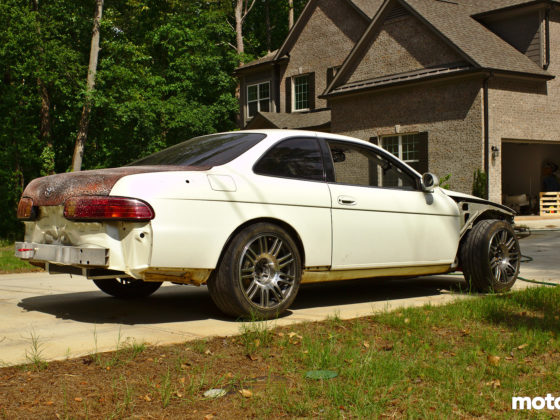
In case you hadn’t noticed, Mercedes moved the turbo to the backside of the engine and placed an air-to-water intercooler on the front. The benefit of moving the turbo to the rear is a shorter exhaust path from the turbo to the cat for better emissions. Plus trying to fit a big downpipe and cat underneath the engine isn’t required which allows the engine to sit lower for a better center of gravity. Also, the turbo and manifold are relatively heavy, so the move places them closer to the center of the car for a reduced polar moment of inertia. Of course, the Evo X did this back in 2008 and Honda moved their header on the K20 to the backside in the early 2000s. Anyway… In case you haven’t noticed again, many of the OEMs have transitioned to air-to-water intercoolers for short intercooler piping for better throttle response among other reasons.

All the OEM intercoolers these days use plastic end tanks (something like PA66GF-30) clamped onto the intercooler core. The orientation of the end tanks on this intercooler with the flow coming in and making a 180 degree turn out is the best for even flow distribution across the core. Check out the inlet side tank and it’s shaped a bit like the catalytic converter entry in order to get more even flow across the core. My S2000 intercooler concept is not too dissimilar. The coolant connections to the intercooler have quick connect fittings and the flow should be in a counter flow arrangement with the airflow to get maximum cooling. The big cooler on the transmission has the same quick-connect coolant fittings. AWD transmission and transfer case need cooling to stay reliable at the power levels the M139 puts out.

The engine cover looks to have a duct attached to it to direct cooling air to the top of the engine. The big silver pipe on the right is from the compressor outlet of the turbo. The big round duct above the pipe goes to the compressor inlet. When making over 200hp/L, restrictions have to be minimized everywhere.

The path between the turbo compressor outlet and intercooler inlet is short and fat for minimal pressure drop. A compressor bypass valve is connected to the turbo outlet pipe and the compressor inlet pipe. It’s the little black cylindrical thingy on the right. A slight manufacturing observation, it looks like they screw in two massive loops on the top of the engine to lift the engine around easily. In the bottom of the picture, the black fitting with the yellow cap is the female end of the coolant quick connect. It just snaps onto the male fitting and the metal retaining clip locks the fittings together. There’s an o-ring inside the female fitting which creates the liquid-tight seal. On the male side, the callout for surface roughness is critical as too rough of a surface will not create a seal with the o-ring. And that’s probably more than most of you wanted to know about fluid quick connects.

The high-pressure fuel pump for the direct fuel injection system is run off the intake cam. A roller is used at the interface of course to reduce friction. None of that old cam follower stuff like on the old Audi 2.0 engine that has high friction and wears out.
The Mercedes AMG M139 engine has employed the basic tuner concept for going big turbo on a small displacement engine which is a twin-scroll and ball bearing turbo. Ball-bearing turbos have been largely absent from production cars. Sure, a couple of the 90’s Nissan cars had Garrett ball bearing turbos. But they haven’t shown back up again until recently as the people have demanded more power while the OEMs have to meet mileage and emissions targets. Ball bearings can also be relatively noisy compared to plain journal bearing turbos, but that’s not a concern on these performance cars with their loud exhausts. The airflow piping is big diameter and the catalytic converter is massive to minimize restriction as much as possible. As is the current trend, an air-to-water intercooler makes for tidy packaging, short airflow plumbing, and likely more consistent intake air temps too. Will we see 250hp/L engines in the future? Maybe…. E-turbos are coming.




18 comments
While I agree getting that much HP out of a 2.0 is impressive I’m not that impressed by the technology involved, nothing here is new or groundbreaking. Where are the axial flow turbines? Where is the eSupercharger/Turbocharger? Where is the ignition prechamber/ jet ignition?
Mahle Powertrain has had all of that stuff working and running in race cars and test mules for the last 5+ years. I remember seing a VW golf 3 years ago with an 48v eSupercharged 1.2L three cylinder pushing 215 hp, way better fuel economy, and a ridiculous torque curve.
I realize new technologies need more testing but with electric cars pushing into the market you would think ICE technology would get off it’s ass and start trying new things.
It’s almost like making it work once in testing or on an F1 engine is completely different than industrializing it for mass production at reasonable cost. Note that 48V eSuperchargers are already on the market, even in AMG products. You need a whole 48V vehicle bus for them though, so it adds a ton of cost.
48 volt could mean a fully electrically operated valve train with tons of possibilities too.
The e-turbos are coming. Actually just saw this Garrett info pop up on their Facebook page: https://www.garrettmotion.com/electric-hybrid/garrett-e-turbo/
They just had to wait for the rest of the vehicle architecture to go to 48V. I doubt prechamber/jet ignition will make it to production anytime soon as it’s easier to just make a hybrid powertrain for mpg improvements.
Nice to know Garrett is getting into it too, theirs looks the most like the F1 MGUH. I knew BorgWarner had one and a bunch of small UK manufacturers have different offerings (the one I saw running was the Aeristech). I agree that 48V is a big step for automotive manufacturing but it isn’t even strictly necessary for e-super/turbocharging, Supergen already makes some that run of standard 12V: http://www.supergen.co.uk/default.asp?contentID=589
I think that jet ignition is not out of question, Mazda just put out an HCCI engine that is as, if not more, complex than jet ignition. It can also be done much simpler than how F1 does it, how they manage it with one injector per cylinder boggles the mind.
Well, Garrett is Ferrari’s F1 supplier 🙂
Also, as already noted, there are already 48V e-boosters in production. Audi has one.
there needs to be some sort of official multiplier (like in racing) for an FI’s engines output per displacement to be considered special. While 208hp/liter is pretty good for an emissions compliant engine, but comparing it to an NA 600cc sportbike engine is like comparing a roid’d up athlete to an excellent specimen of an athlete without roids…
That’s a BorgWarner “BB03” turbo. B03 frame size like the previous AMG 2.0l but with the new ball bearing center section. The dual torx/hex head compressor housing to backplate bolts and the forged rod ends with small E-clips for the actuator linkage are typical BorgWarner designs.
Thanks for the ID. I’ve been out of the turbo game for a while now. I’m use to the older BW turbos having the wastegate rod going through a block thing attached to the arm on a shaft and two nuts like on the EFRs. I always thought it was way overkill. Good to see they joined the rest of the turbo suppliers with the simple e-clip joint.
“The new Ferrari F8 will have a similar spec turbo. Anyway, the turbo on the M139 engine probably just slightly bigger wheels.”
Was this meant to say the M139 engine is probably the same as the F8/488 Ferrari sourced turbochargers?
Great article and love the tid bits about the torque gun and production considerations. Stuff you never see from the aftermarket.
Well, DobRahm pointed out the M139 uses a Borg Warner turbo and I THINK the Ferrari turbo is from IHI. Horsepower per turbo though, they are relatively close. The wheel diameters are probably within a few millimeter of each other.
Oh, and we’re all very eagerly awaiting a progress report on your S2000 GT3RS killer turned street car build! Your write ups are great, keep them coming.
Man…. S2k parts are getting hard to come by. And I’ve had to watch my budget. That said, I FINALLY got some engine bearings a couple weeks ago after waiting for half a year. I might have gotten the last set of King Bearings in North America for the S2k from Real Street Performance. I got to meet the head engineer/PhD at King Bearings a few months ago. Learned a LOT.
Feel free to share that knowledge with a bit here on MotoIQ about it! Look forward to that story.
I’m not surprised you’re finding S2k parts hard to come by. She’s getting to be an old bird and lots of people are already starting to ‘keep them 100% stock’ for resale purposes. Bringatrailer isn’t helping the price of used ones for folks like me
How far off are we from electronic wastegate actuators being produced by aftermarket performance companies?
While companies like MAHLE produce them they still seem OEM based, eg no bolt-on EFR/GTX units.
The industry-wide adoption doesn’t seem there,
I haven’t seen an ECU company offer out of the box support as they have with DBW
just an FYI, plenty of other twin scroll V-band IWG OEM turbos around. Starting with the BMW S63 all the way back in 2012 and all its subsequent iterations, and even the later N63TU2/R variants. All Garrett MGT22xx variants. The AMG M178 also uses a very similar setup to the M139 (due to it in fact, being quite literally twice the motor)
I worked a bit with the engineers who were the application engineers for the MGT22s on the S63. Those were not ball bearing though which is the primary difference with the newer turbo on this engine.